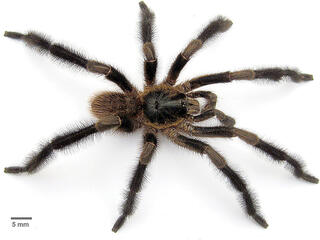
The Greater Antilles - which include, among others, Cuba, Jamaica and Puerto Rico - are a natural laboratory for the study of the formation of species. Although these islands were once connected and share many geographical features, they have been separated for millions of years. This long isolation, plus natural barriers, has led to each species on these Caribbean islands evolving in its own unique way, leading to great diversity and the species being endemic to each of the islands, with unique adaptations.
Spiders, especially tarantulas, exhibit amazing diversity in this area. A study published in the Journal of Natural History describes a new species of tarantula named Trichopelma grande, which was discovered in Cuba and boasts unusual body dimensions and hairiness for its type. 3 View gallery A male spider of the new tarantula species Trichopelma grande ( Photo: David Ortiz, Journal of Natural History ) The phys.

org website announced that the pair of researchers who discovered it - Dr. David Ortiz from the University of Masaryk in the Czech Republic, and Valerie Fonseca from the Cuban Zoological Society - conducted a phylogenetic analysis using a sequence of short segments of DNA, called "Ultraconserved Elements," which change very slowly throughout evolution, so that it is possible to use them to compare evolutionarily distant species, but also to identify new species with them. After the genetic sequencing conducted by the researchers, the data were compared to those from 27 other species in the Theraphosidae family.
From the final data it emerged that the new species is a relative of another species called Trichopelma laselva from Costa Rica, which indicated that it belongs to the Trichopelma genus, which so far includes 22 species found throughout the Antilles, including five discovered in Cuba. 3 View gallery Anatomy of the new tarantula species Trichopelma grande ( Photo: David Ortiz, Journal of Natural History ) The new species exhibits several unique features, beyond a body length ranging from 8.4 mm -11.
1 mm. Adult males have an abundance of long hairs on the middle and lower part of their legs, which gives the legs a feather duster-like appearance. This is an unusual trait for a ground-dwelling species, as it is usually associated with tree-dwelling tarantulas.
In addition, spots and several dark and light transverse stripes were discovered on the belly of the new species, crossed in the center by a light longitudinal stripe. The new species of tarantula also is covered with a hairy mantle on the upper part of its body, with chestnut-brown hair, although there are areas of its body that are completely hairless. Also, the size of its head far exceeds that of other known species of this type, giving it a peculiar and quite frightening appearance.
3 View gallery Viñales National Park, where the new tarantula species Trichopelma grande was discovered ( Photo: Shutterstock ) The large hairy spider was discovered in Viñales National Park, a biodiversity hot spot in western Cuba. A total of four spiders of the species Trichopelma grande were found, at a distance of 20 km from each other, which indicates a rather limited distribution. Since only a few individuals of the new species have been discovered, together with its limited habitat, make it an endangered species.
Viñales National Park is gradually being destroyed due to human activity, including cutting down trees, and extreme weather events such as hurricanes. Therefore, only certain areas of the forest remain intact, which puts rare species of their kind at risk. Get the Ynetnews app on your smartphone: Google Play : https://bit.
ly/4eJ37pE Apple App Store : https://bit.ly/3ZL7iNv >.














